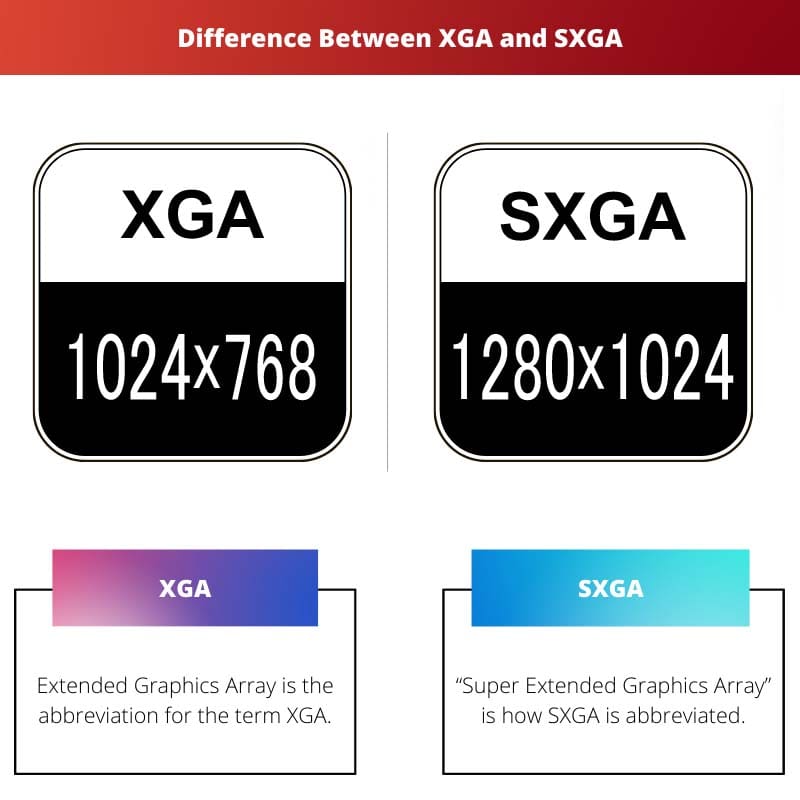Pictures and Image qualities matter a lot due to the reason that the amount of pixels in an image determines its clarity, this fundamental difference between the two renders SXGA images much crisper and more detail-oriented than XGA images.
Key Takeaways
- XGA (Extended Graphics Array) has a resolution of 1024×768 pixels, while SXGA (Super Extended Graphics Array) has a resolution of 1280×1024 pixels.
- SXGA provides higher image quality and clarity compared to XGA.
- XGA is more common in older monitors, while SXGA is found in newer, higher-resolution displays.
XGA vs SXGA
The difference between XGA and SXGA lies mainly in the difference in the aspect ratio they adhere to and the resolution they offer. However, the former is widely used in CRT monitors due to the lesser resolution offered, and the latter is used in the case of LCD monitors. The resolution of the Extended Graphics Array, or XGA, is lower than that of the SXGA or Super XGA.

Extended Graphics Array is the abbreviation for the term XGA. IBM, on the other hand, has created a standard of measurement. XGA produces a resolution of 1024×768 pixels, which has become the de facto norm for accessing websites.
While surfing and functioning through internet sites, you may see how the XGA is used and contributed to. “Super Extended Graphics Array” is how SXGA is abbreviated.
The resolution of SXGA, or Super Extended Graphics Array, is 12801024 pixels, which is higher than that of XGA. In the case of mobile phone wallpapers and cameras, the higher resolution afforded by SXGA was preferred over time until it was replaced with higher and better resolutions.
Comparison Table
| Parameters of Comparison | XGA | SXGA |
|---|---|---|
| Acronym/full form | Extended Graphics Array. | Super Extended Graphics Array. |
| Resolution offered | 1024×768 | 1280×1024 |
| Use and Contribution | Browsing and operating through online sites. | Mobile phone wallpapers, cameras. |
| Aspect Ratio | Follows the aspect ratio of 1.333:1 or 4:3. | Follows the aspect ratio of 5:4 or 1.25:1. |
| Aspect Ratio Uses | CRT monitors. | LCD monitors. |
What is XGA?
Extended Graphics Array is the abbreviation for the acronym XGA. However, IBM has created a standard of measurement for this. The Extended Graphics Array, or XGA, has a lower resolution than its Super XGA equivalent.
XGA produces a resolution of 1024×768, which has become the de facto norm for surfing websites. While surfing and operating through websites, the XGA’s use and contributions can be viewed.
The aspect ratio of 1.333:1 or 4:3 is known to be followed by an Extended Graphics Array, which was already established in the case of normal screens, where images appear almost always exactly as they should look.
XGA, or Extended Graphics Array, is a resolution that is only found and viewed on CRT monitors. The high-quality photos and precise clarity of this format have made it famous.
The characteristics of the XGA were vastly superior to those of its predecessor. Non-interlaced monitors are also supported, which was previously unavailable in such formats.
What is SXGA?
“Super Extended Graphics Array” is the abbreviation for SXGA. The resolution of Super Extended Graphics Array, or SXGA, is 12801024 pixels, which is higher than that of XGA.
In the case of mobile phone wallpapers and cameras, the higher resolution afforded by SXGA was preferred over time until it was supplanted by higher and better resolutions.
The Super XGA or SXGA did not adopt or follow the 4:3 aspect ratio; instead, it adopted the 5:4 or 1.25:1 aspect ratio. These are easily adaptable to modern display screens. However, vintage CRT displays may have difficulties, such as distortion.
In the case of LCD monitors, the native resolution of SXGA is frequently employed. LCDs, on the other hand, have a considerably higher and better resolution than Super XGAs at the moment.
Main Differences Between XGA and SXGA
- The acronym of XGA can be written as Extended Graphics Array. However, the standard of measurement of this is IBM established. On the other hand, the acronym of SXGA can be written as “Super Extended Graphics Array”.
- Extended Graphics Array, or XGA, possesses a relatively lesser resolution than its counterpart, Super XGA. The resolution produced by XGA is 1024×768, which has, over time, become the basic standard for online site browsing. On the other hand, in the case of Super Extended Graphics Array, or SXGA, the resolution possessed is 1280×1024, which is relatively higher than that offered by XGA.
- The use and contributions of the XGA can be seen while browsing and operating through online sites. On the other hand, The higher resolution offered by SXGA was preferred over time in the case of mobile phone wallpapers, cameras until it was replaced with higher and better resolutions.
- Extended Graphics Array is known to follow the aspect ratio of 1.333:1 or 4:3, which was already established in the case of standard displays where the images appear exactly how they should appear almost all the time. On the other hand, the Super XGA or SXGA did not acquire or follow the 4:3 ratio. Rather it has adapted the aspect ratio of 5:4 or 1.25:1. These can be very well adapted to newer display screens. However, it can possess issues like distortion in CRT old displays.
- XGA or Extended Graphics Array possesses a resolution that is exclusively and commonly found and seen in the case of CRT monitors. On the other hand, the native resolution offered by SXGA is used in the case of LCD monitors. However, at the current time, the LCDs possess much higher and better resolution in comparison to those offered by Super XGAs.






